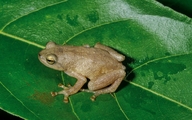|
Description
M 27-29 mm. Tympanum indistinct, 1/3-2/5 of eye diameter. Tibiotarsal articulation reaches the eye. Toe 3 slightly shorter than toe 5. Skin smooth. Colouration variable, often uniformly brownish on back, a beige vertebral line can be present. Sometimes with broad beige dorsolateral bands on the flanks. Ventrally uniformly beige-greyish (Glaw and Vences 2007).
Similar species: Cophyla berara is slightly smaller and has much longer notes in advertisement calls. C. occultans occurs sympatrically with C. phyllodactyla but is distinctly smaller. Several Platypelis species can be confused with Cophyla as well (Glaw and Vences 2007). Distribution and Habitat
Country distribution from AmphibiaWeb's database: Madagascar
Benavony, Lokobe, Manongarivo, Montagne d’ Ambre, Nosy Be, Nosy Komba (Glaw and Vences 2007). It ranges from near sea level to 1100 m asl, and is found in both pristine and disturbed rainforest, as well as plantations (ylang-ylang, coffee, cacao) (Glaw and Vences 2008).Life History, Abundance, Activity, and Special Behaviors
Habits: Males call at night on leaves at perch heights of 1.5-3.5 m. Often in rainforest, but on Nosy Be the typical calls of this species can be commonly heard also from ylang-ylang plantations and secondary and disturbed vegetation. During the day found in bamboo holes. One male was found with eggs and tadpoles of different developmental stage in a water-filled bamboo trunk (Glaw and Vences 2007). Has non-feeding larvae (Glaw and Vences 2008).
Calls: A single melodious note that is repeated after regular intervals in long-lasting series. Note repetition rate is about 60/min (Glaw and Vences 2007). Trends and Threats
Common. Thought unlikely to be threatened since it can tolerate altered habitat. However, if sugar cane farming spreads, which results in a much more open habitat, it is likely to represent a serious threat (Glaw and Vences 2008).
It occurs in four protected areas: Réserve Naturelle Intégrale de Lokobe, Parc National de Montagne d'Ambre, Monongarivo Special Reserve, and Réserve Naturelle Intégrale du Tsaratanana (Glaw and Vences 2008). Comments
Taken with permission from Glaw and Vences (2007).
References
Glaw, F., and Vences, M. (2007). Field Guide to the Amphibians and Reptiles of Madagascar. Third Edition. Vences and Glaw Verlag, Köln.
Glaw, F., and Vences, M. (2008). Cophyla phyllodactyla. In: IUCN 2008. 2008 IUCN Red List of Threatened Species. www.iucnredlist.org. Downloaded on 01 May 2009.
Originally submitted by: Miguel Vences and Frank Glaw (first posted 2009-05-01)
Edited by: Kellie Whittaker (2010-07-18)Species Account Citation: AmphibiaWeb 2010 Cophyla phyllodactyla <https://amphibiaweb.org/species/2331> University of California, Berkeley, CA, USA. Accessed May 12, 2025.
Feedback or comments about this page.
Citation: AmphibiaWeb. 2025. <https://amphibiaweb.org> University of California, Berkeley, CA, USA. Accessed 12 May 2025.
AmphibiaWeb's policy on data use.
|
